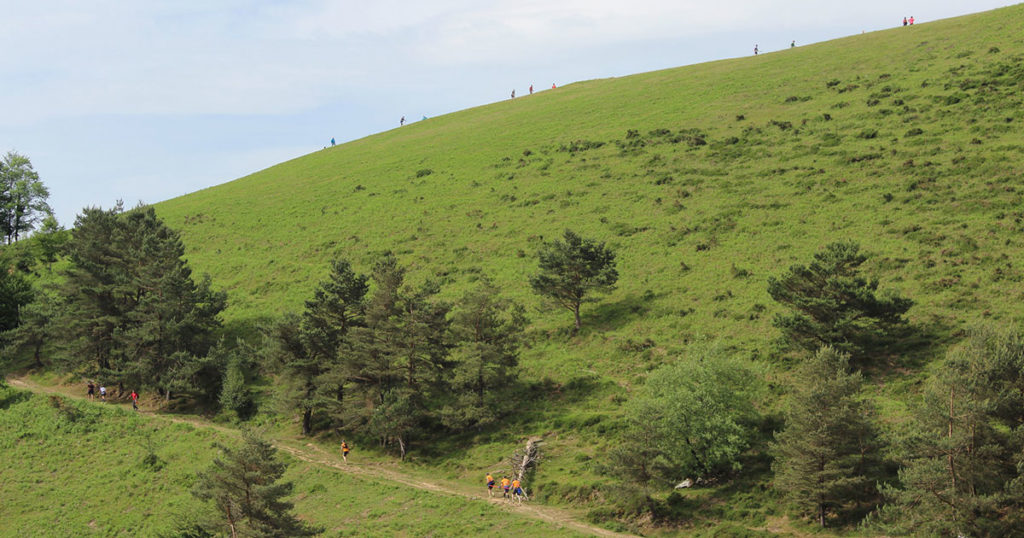
The Zegama-Aizkorri is the world’s most popular foot race, but I had never heard of it. Is that on a par with never having heard of the Tour de France, Wimbledon, or the World Cup? Not at all. Running is growing in popularity as a pastime, and more and more people care about running at all levels, but the sport still doesn’t have the audience of long-established team sports, or individual arena-style sports played on a court, or exhibitions of dexterity such as figure skating or gymnastics. The names of trail races do not ring many bells, and though Olympic runners enjoy some fame, who besides the aficionados has ever heard of Kílian Jornet? Not I. The runners that come to my attention in the news are not the victorious ones but the victims of their sport, like the 21 elite Chinese runners who died last year in an ultramarathon in the mountains when the weather turned freezing, or the two trail runners who died in Asturias last year, one when training and the other in a race. So when my running partner thrust the tablet in my face and pushed the play button for a video, and the name of Zegama-Aizkorri appeared at the top, I was clueless. I asked him where it was. I should have guessed from the name. We’d just returned from País Vasco, Basque Country, where we’d run a 12K trail race on the weekend, in Santurces, on the outskirts of Bilbao. My mother had gone along for the drive, and I had pointed out to her the abundance of the letters i, t, k, and z in the street signs and shop names we saw, starting with the town itself, which in Basque is Santurtzi.
The video my friend played showed footage from the 19th edition of the Zegama race, a mountain marathon, in May 2022. More than half the 500 spots were reserved by the organization for special guests, including runners of previous editions. For the raffle of the 225 remaining spots, 12,000 requests came in, making the odds of getting into the race worse than those of getting into the Ivy Leagues. The participants were mostly elite runners. They would have to be for this race, which introduced me to a new category in mountain running: extreme ridge-running.
We had watched a different video earlier—footage from the race we’d run in Santurtzi, the Serantes Igoera race, named for the mountain the racecourse tops. It was easy to find the part of the video showing our finish: we came in last. Yet, considering everything, our arrival was triumphant. With my first steps in the race, the hip soreness I had felt before the event turned into something else. My left leg seemed to have no strength. Climbing meant dragging it behind me. When I forgot my leg and trusted my weight to it, it gave out and I stumbled. Runners passed me, and my partner, who stood no chance of a trophy that day, soon saw that I didn’t either. “Just don’t make us last,” he begged. So I ran. And I fell. Not on the sharp rocks at the top where I’d limped along, but on a forest path padded with leaves and moss. I got up and ran on. Runners kept passing. I tried to keep up. My partner, who had been urging me to hurry, now urged me to go easy.
Near the end, returning to the town from the slopes above it, another pair of runners, a man and a woman, passed us. We were now last, behind us only the escobas—the runners bringing up the rear to make sure no one got lost along the course. Close to the finish line, runners were channeled into a cordoned path between the traffic on one side and the pedestrians on the other. Both sides were lined with spectators leaning over the tape, making the last 500 meters a happy gauntlet. The video shows me grimacing, but I recall grinning as I ran the last few hundred meters between lines of cheering spectators. All these people, cheering, yelling, clapping! For me! I was thrilled. I felt as if I’d come in first, not last. In the hundreds of races I’ve run, I had never seen such a turnout. It was fantastic.
In the Zegama-Aizkorri race, 42 kilometers from the village of Zegama to the Aizkorri peak, the participants were cheered not only at the outset and at the end but also at every step along the way. I judged from the video that, just to see the race, the spectators had covered the same steep, rough, dangerous ground that the runners contended with. It must be the Basques, I thought. Ocho Nombres Vascos, literally “Eight Basque Surnames,” but in English titled Spanish Affair, is a popular Spanish comedy from 2014 that pokes fun at the stereotype of Basques as serious, inexpressive people. Does anyone really believe that? They are the warmest, most supportive, and most enthusiastic of people. I’d thought so after the Behobia race in San Sebastián in 2019, but now I knew. Didn’t every single person along the last meters lean over the separating tape to cheer? Not the world’s most popular race, but they were cheering wildly. I felt like they had all come just for me. Yes, it had seemed they were cheering only for me, as I told my son.
“They were,” he said. “They were cheering only for you.” He laughed. “There was no one else coming along after, no one else to wait and cheer for.” He was right. “You were all alone.” We were all alone. The last. But no one ever let on.

